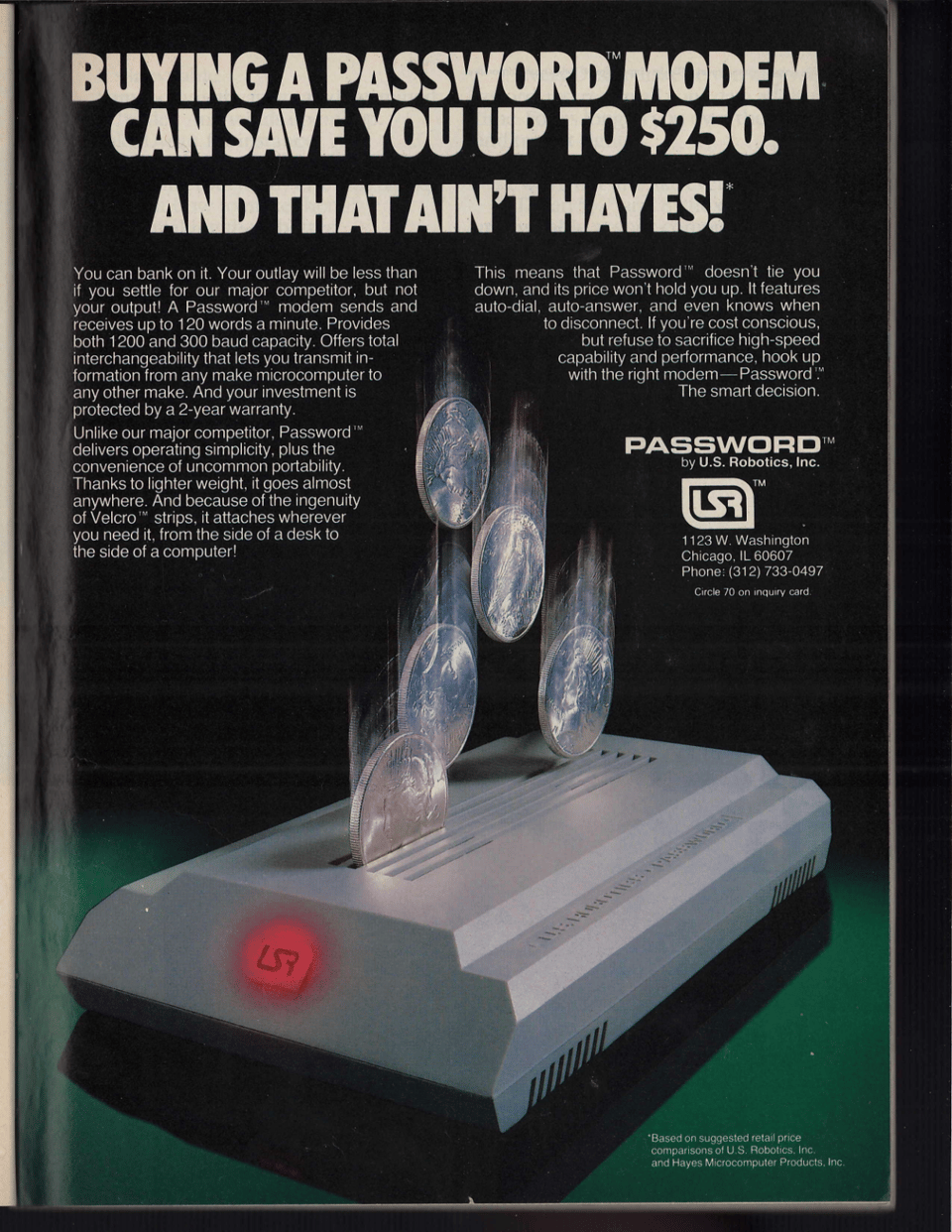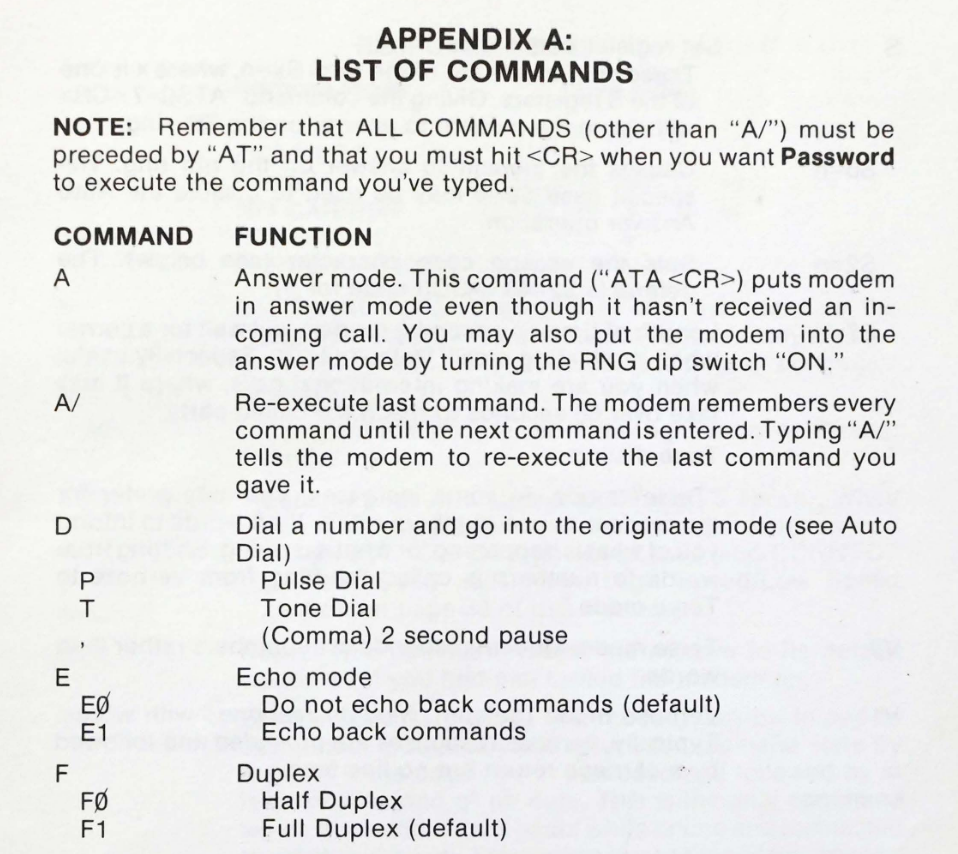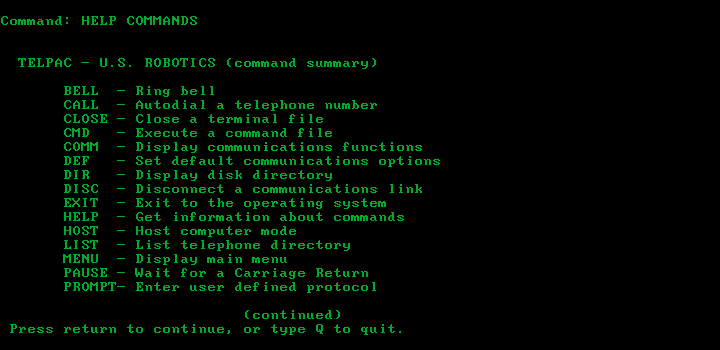USR's campaigns for the Password Modem were historically bad ads
What's the point in rewriting the timeline of a famous figure's if you're not going to make it baroque?
This newsletter does not contain ads, sponsored posts, or affiliate links. Open and click tracking are disabled. And there is no paid upgrade. Enjoy.

They could’ve referenced Benjamin Franklin the inventor when introducing their new modem. Or as one of the five original drafters of the Declaration of Independence when mentioning editorial benefits. Maybe his stint as the first postmaster general? Nope! They went with an oblique reference to a magazine launched 33 years after Franklin’s death.
And where in the ad is the Password modem? (Yes, they had the trademark) Clinging to the side of the display in the least eye-catching way possible. “Easily portable, it parks almost anywhere thanks to the convenience of Velcro strips.” (InfoWorld August 1984)
U.S. Robotics’ unassuming little gray box was an auto-dial, auto-answer modem. “One of the most advanced communication devices in the world,” according to its instruction manual. An assertion their marketing team worked hard to reinforce by setting all of their ads in 18th century America:

Feels like an unnecessary indictment of indolence. But it is a quaint callback to when tech advertised “More time for relaxation!” Instead of “More time for…more work!”
Not mentioned in this ad about sleeping next to your modem is Password’s “built-in speaker with an adjustable volume control so you can listen to the dialing and connection and determine if the reason for no carrier is a busy signal, dead line, or no answer,” a 1985 Macintosh Expansion Guide clarified, ending with a caveat that “the volume control on the modem can be adjusted with an Allen wrench.”
For those born after 1984 and/or still catching up on internet history (Hi, it’s me), U.S. Robotics was not the first to this game. Hayes Microcomputer Products introduced its 300-baud Smartmodem in 1981, with the ability to “examine the data flowing into the modem from the host computer, watching for certain command strings.” Our nerdy forefathers quickly turned those strings into the software that became the first BBSes, which is all just context to explain that you needed software to set up auto-dialling and auto-answering. “Any communications software tailored for the Hayes Smartmodem will work with [the Password],” according to The Peter McWilliams personal computer buying guide.
U.S. Robotics recommended their Telpac software, however, in both the Franklin and Revere ads. What both of those spreads neglect to mention (but is mentioned in this 1983 ad in Byte) is that Telpac was a separate $79-$99 purchase. This, despite most of their other campaigns’ hammering Hayes on cost:

Feedback on the hardware and software seemed to be a mixed bag. Diane Croft called the customer support “the most helpful computer people anywhere,” in The Ultimate Guide to Peripherals for the Blind Computer User, calling out that “U.S. Robotics initiated a call to National Braille Press to underwrite the cost of producing their manual In braille. That meant a user may receive a braille copy from the Press at no charge.” But accessibility is about more than the medium. And as Benjamin Franklin said, they first had to find 100 ways to do it wrong in order to avoid failure.
inCider Magazine’s 1984 review complained that you had to have a compatible serial interface card and that “Unfortunately, you don't find this out until you read up to page 56 of one of the three manuals.” And that was before learning to use the terminal interface!

You could use the Password without additional software, it’s just that features were limited to the Hayes’s AT command set. For example, ATDP 123-4567 ,,, T 888-888 ,,, 312-123-4567 <CR> would start a dial/pulse call to a phone number, wait two seconds for each comma, switch to tone dialing, send six digit tones over the line, wait two seconds for each comma, then send a long-distance number over the line.
Appendix E of the Password manual was surprisingly empathetic about the whole thing. “The most important thing to remember about data communications is that it is difficult, even for advanced users, to make everything work right the first time.” Or, maybe, they were just pitching their paid add-on.
“U.S. Robotics' TELPAC…gives you a lot of potential in data communications, and makes the whole thing much easier to operate in general.” Unless you’re Ben Grubbs trying to use the software 40+ years later, screaming “Why isn’t there any documentation [on the disk]!?” He did manage to track down this not-so-bad ad that I cannot find anywhere else, though:

Based on the Revere ad copy, Telpac would let you list up to 14 endpoints (phone numbers) for the modem to dial, then transmit your text, hangup, and dial the next number on the list. You could schedule it for the middle of the night, when rates were cheaper or at predetermined publishing times from services like The Source or BRS After Dark.
While I couldn’t find the Telpac manual in PDF form, Ben Grubbs’s video (which has dozens of fun technical details I am far too unqualified to comment on) has a few shots of the interface. You can also find a few over at WinWorld:

Sans Telpac, the Password retailed for $449 ($199 for the 300-baud-only model) with a standard Bell 212A inside (Bell 103 for 300-baud-only). It was similar to the Apple Modem (also manufactured by U.S. Robotics) and seemed the same or worse than any of Hayes’s offerings in every way, except the Velcro.
Still, U.S. Robotics released a 2,400 baud model a year later, and the massively popular 9600 baud Courier HST one year after that. Proof that you can incorrectly tie a Founding Father to a 19th-century magazine, call a war hero lazy, and sysops guys will still give you all their money!
Links to Resources:
Byte Jan 1984 (PDF page 59)
Trademark 73429624 - PASSWORD, Apr 1985
InfoWorld August 1984 (page 4)
1985 Macintosh Expansion Guide (page 75)
The Peter McWilliams personal computer buying guide (page 358)
Byte Dec 1983 (PDF page 132)
Popular Computer Aug 1984 (PDF page 21)
The Ultimate Guide to Peripherals for the Blind Computer User (page 84)
inCider Magazine (page 143)
Video: THE PASSWORD: Checking out an ancient US Robotics modem